

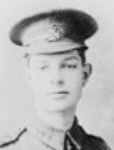
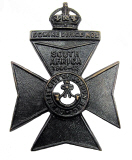
No.1280, Sergeant, George CRANN
Aged 20

|
George Crann was born in Peckham in 1895,( Greenwich Q3-1895 1D:1097), son of Alfred John and Ellen CRANN (née KING).
1901 census...Aged 5, he was at 1 Rutts Terrace, St Paul Deptford, Greenwich with his father Alfred John CRANN [33] timekeeper (printers) born Peckham; his mother Ellen [34] born Harrogate, Yorkshire, brothers (Alfred)Willie [6] and Godfrey (Herbert) [3] both born in Peckham. 1911 census...Aged 15, a stereotyper, he was 1 Rutts Terrace, Dennetts Rd, Queens Road, New Cross, Peckham, with his parents (father now a publican - out of business) and brother Alfred William (machine minder) and brother Godfrey Herbert. Sometime between the 1911 census and George's death the family moved to the "Royal Oak" at Lidgate. The Royal Oak, originally the "White Hart" is a grade 2 listed building is now Oak House on Front Street, at the junction with Bury Lane. His father died in 1922 and he mother was later at 3 Loxton Road, Forest Hill, London. His younger brother Godfrey died in Belgium in 1917 see here |
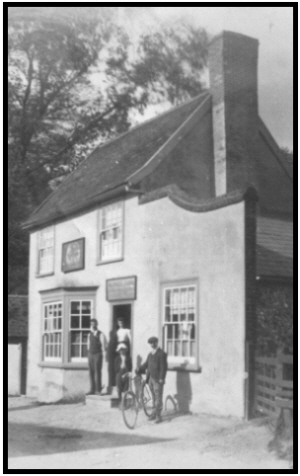
Royal Oak, Lidgate, with George's father Alfred in doorway
photo is the cover of "Happy Lidgate" by Anthony Foreman, to whom also thanks for the photograph of George

|
He enlisted in New Cross, resident in Peckham.
The 6th Battalion were known as the "Cast Iron Sixth" on account of their severe black painted cap badge, a version of the King's Royal Rifles badge. Several of the brothers' letters home are kept by the National Archives. The following is an extract from one of his letters home: "We have spent sixteen days in the trenches, twelve of which we spent in the firing line and four in support so you may guess we have had enough of it for one turn. We did not have our boots off the whole time. Taking our clothes off is a thing of the past. I have not had mine off (except for an occasional wash) since April. We indulged in a bath and change of clothes on Sunday (first for about 4 weeks) . Oh for the times when we can have a regular Saturday night scrub, even if we do stick to the chair. I hope you are enjoying your holiday. I did think that we might get leave, but the chance is now very small. Leave was started last week but only at the rate of one man per company, at that rate it will take four years to go round, so unless the percentage is raised I don't think we stand much chance. A week or two at "Happy Lidgate" would just suite me now after having been almost a year without having had one clear day off. I suppose we shall have to wait till the war is over and then Oh what a time we will have, to make up for what we have lost. We still have our daily "sport" (hunting) but the bag has been much smaller lately - as we had a clean change about a fortnight ago. In another week or so they will be getting lively." The notification of his death 6th October 1915- "It is with the deepest regret that I have to inform you that your son, Sergt G.Crann was killed in action on Sept 25th while leading his platoon into the attack. His death was that of a soldier and a brave man, but fortunately it was painless as he was killed instantly. I shall miss him immensely as he was my platoon sergeant and always proved a smart, thorough and reliable N.C.O. I am also very sorry to have to inform you that his brother Rifleman Crann was wounded the same day, but I believe only quite slightly and I trust you will soon have him home convalescent quite shortly." The brother mention here was William, in the same battalion as George. RIFLEMAN WILL CRANN - 6th Bn., London Regiment was seriously wounded with his brother George at the Battle of Loos, but lived to a ripe old age, working for the Amalgamated Press, following his father's trade. Battle of Loos:- At 5.50 am on 25th September 1915 the British released gas for the first time with the troops timed to advance 40 minutes later. The British attack was SE towards Loos, astride the Bethune-Lens Road. There is a detailed account of the operation on http://www.1914-1918.net/bat13.htm briefly though , the 1/6th battalion's objective was the German trench system running from a mining spoil tip known as the Double Crassier to the Lens-Béthune Road. The battalion reached the German front line with few casualties, but the wire in front of the second line was a more serious obstacle, there was no natural cover, and the battalion suffered many casualties here. However, the objectives were taken by 08.00, after which the battalion consolidated its position and beat off counter-attacks. CWGC records 95 men of the battalion killed on the 25th, 89 are commemorated on Special Memorials at Maroc Cemetery, known to be buried here, but the exact graves were lost.
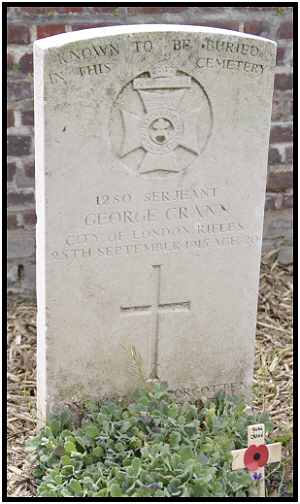 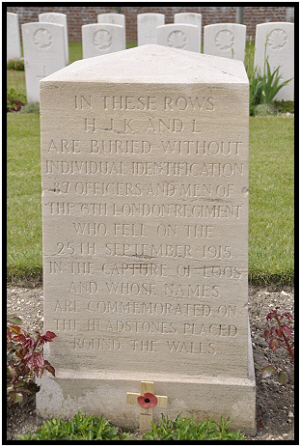 photos: Rodney Gibson photo:Rodney Gibson click here to go to the Commonwealth War Graves Commission website for full cemetery/memorial details |